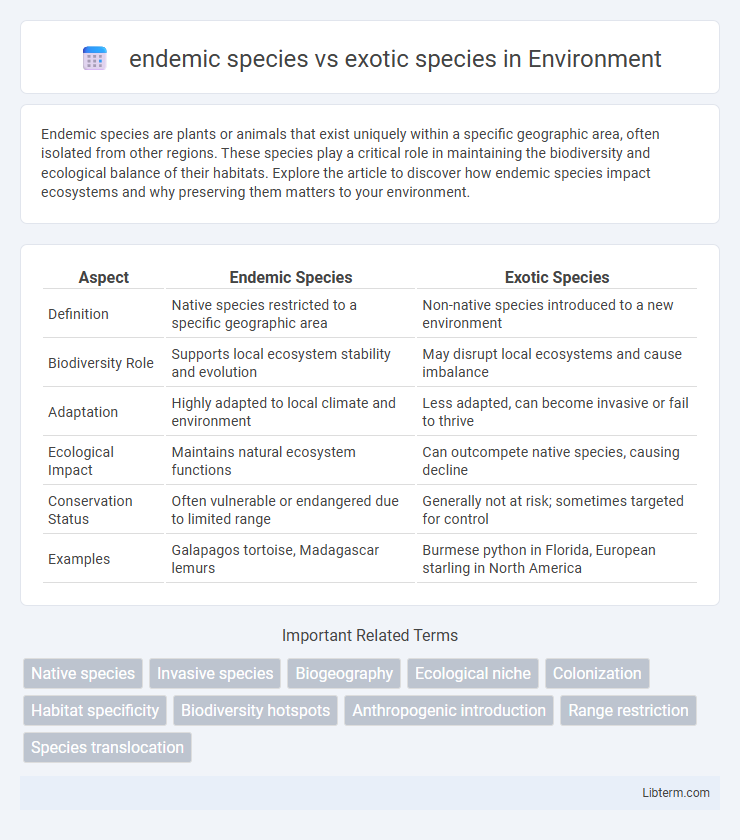Endemic species are plants or animals that exist uniquely within a specific geographic area, often isolated from other regions. These species play a critical role in maintaining the biodiversity and ecological balance of their habitats. Explore the article to discover how endemic species impact ecosystems and why preserving them matters to your environment.
Table of Comparison
| Aspect | Endemic Species | Exotic Species |
|---|---|---|
| Definition | Native species restricted to a specific geographic area | Non-native species introduced to a new environment |
| Biodiversity Role | Supports local ecosystem stability and evolution | May disrupt local ecosystems and cause imbalance |
| Adaptation | Highly adapted to local climate and environment | Less adapted, can become invasive or fail to thrive |
| Ecological Impact | Maintains natural ecosystem functions | Can outcompete native species, causing decline |
| Conservation Status | Often vulnerable or endangered due to limited range | Generally not at risk; sometimes targeted for control |
| Examples | Galapagos tortoise, Madagascar lemurs | Burmese python in Florida, European starling in North America |
Understanding Endemic Species
Endemic species are organisms native to a specific geographic region, found nowhere else on Earth, often evolving unique traits due to isolation. These species play crucial roles in maintaining ecosystem stability and biodiversity within their habitats. Conservation efforts prioritize endemic species because their limited distribution makes them highly vulnerable to environmental changes and human activities.
Defining Exotic Species
Exotic species, also known as non-native or introduced species, are organisms that have been transported to an area outside their natural geographic range, often through human activities. These species can establish populations in new environments, sometimes disrupting local ecosystems and outcompeting endemic species. Understanding the distinction between exotic and endemic species is crucial for biodiversity conservation and ecosystem management.
Key Differences Between Endemic and Exotic Species
Endemic species are native organisms restricted to a specific geographic area, whereas exotic species are introduced from other regions and can establish populations outside their native habitats. Endemic species often evolve unique adaptations to their local environments, contributing to regional biodiversity and ecological balance, while exotic species may disrupt ecosystems by outcompeting native species or introducing diseases. Conservation efforts prioritize protecting endemic species due to their limited distribution and vulnerability, in contrast to managing exotic species to prevent invasive impacts on natural ecosystems.
Ecological Roles of Endemic Species
Endemic species play critical ecological roles by maintaining biodiversity and stabilizing ecosystems within their native habitats, often evolving unique adaptations that support specialized interactions with other local flora and fauna. These species contribute to nutrient cycling, pollination, and habitat structure, which exotic species may disrupt when introduced, leading to competition, predation, or disease spread. Protecting endemic species is essential for preserving ecological balance and resilience in regions vulnerable to environmental changes.
Impacts of Exotic Species on Local Ecosystems
Exotic species often disrupt local ecosystems by outcompeting endemic species for resources, altering habitat structure, and introducing diseases to which native species have no immunity. These biological invasions can lead to declines or extinctions of endemic species, thereby reducing biodiversity and destabilizing ecological balance. The economic costs and management efforts required to control invasive exotic species further highlight their significant environmental impact.
Factors Influencing Species Distribution
Factors influencing species distribution include climate, habitat availability, and human activities, which shape the presence of endemic species restricted to specific geographic areas versus exotic species introduced from other regions. Endemic species often evolve unique adaptations to local environmental conditions, while exotic species may become invasive, disrupting native ecosystems. Geographic isolation and ecological niche specificity play crucial roles in determining the limited range of endemic species compared to the broader potential range of exotic species.
Conservation Challenges for Endemic Species
Endemic species face unique conservation challenges due to their limited geographic distribution, making them highly vulnerable to habitat loss, climate change, and invasive species. Unlike exotic species, which often thrive in varied environments and can adapt or migrate, endemic species have specialized habitat requirements that restrict their survival options. Protecting these species requires targeted conservation strategies that preserve their natural habitats and mitigate threats posed by environmental changes and human activities.
Managing the Spread of Exotic Species
Managing the spread of exotic species requires targeted intervention to protect endemic species and maintain ecosystem balance. Effective strategies include early detection, rapid response, and the implementation of biosecurity measures to prevent accidental introductions. Public awareness and habitat restoration also play crucial roles in minimizing the impact of invasive exotic species on native biodiversity.
Case Studies: Endemic vs. Exotic Species
The Galapagos Islands illustrate the stark contrast between endemic species like the giant tortoise and exotic species such as goats, where invasive goats have disrupted native ecosystems by overgrazing. In Hawaii, the endemic honeycreeper bird species suffer declines due to introduced predators like rats and exotic plants that outcompete native flora. These case studies highlight the ecological imbalance caused by exotic species introductions, demonstrating the urgent need for targeted conservation strategies for endemic species preservation.
Strategies for Biodiversity Protection
Endemic species require targeted conservation strategies such as habitat preservation and restoration to maintain their restricted geographic ranges, while exotic species management often involves controlling invasive populations to prevent ecological imbalance. Protecting biodiversity hinges on implementing region-specific protection laws, promoting native species propagation, and monitoring ecosystem health to mitigate threats from invasive exotics. Integrating scientific research with community engagement enhances the effectiveness of biodiversity protection strategies by fostering sustainable coexistence between endemic and exotic species.
endemic species Infographic

 libterm.com
libterm.com